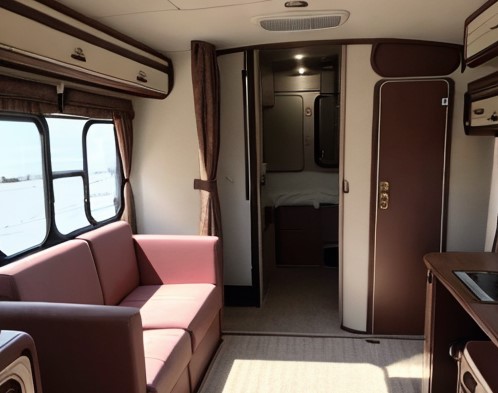
Embarking on the journey of camper ownership is an exciting venture into the world of nomadic living, but it comes with its own set of considerations, with one of the most crucial being camper weight. Understanding the weight dynamics of campers is essential for safe towing, compliance with regulations, and an overall enjoyable travel experience. In this comprehensive guide, we will explore the various aspects of camper weights, including classifications, towing capacities, weight distribution, and the impact of weight on camper safety and performance.
Importance of Understanding Camper Weight
- Safety and Stability: The safety and stability of your camper and towing vehicle are paramount considerations. Understanding and adhering to weight limits ensure that your rig remains stable on the road, reducing the risk of accidents or issues related to swaying, fishtailing, or loss of control.
- Legal Compliance: Government regulations and road safety laws dictate maximum weight limits for trailers and towed vehicles. Exceeding these limits can result in fines, penalties, or even the impoundment of your camper. Staying within legal weight parameters is crucial for hassle-free travel.
- Towing Efficiency: Camper weight directly affects the towing efficiency of your vehicle. Overloading can strain your engine, transmission, and braking system, leading to increased fuel consumption, wear and tear, and reduced overall performance. Understanding and managing camper weight contributes to a smoother and more efficient towing experience.
Types of Camper Weights
Dry Weight: Dry weight, also known as base weight, refers to the weight of the camper without any additional cargo, fluids, or passengers. It includes the essential components such as the chassis, frame, walls, roof, and basic appliances. Dry weight serves as a baseline for understanding a camper’s weight before adding personal belongings.
Gross Vehicle Weight Rating (GVWR): GVWR is the maximum allowable weight of a fully loaded camper, inclusive of all cargo, fluids, and occupants. Exceeding the GVWR can compromise the structural integrity and safety of the camper, as it surpasses the manufacturer’s design limitations. GVWR is a critical factor in ensuring a safe and compliant travel experience.
Gross Axle Weight Rating (GAWR): GAWR specifies the maximum weight each axle can support. It is crucial for distributing weight evenly across the axles to maintain stability and prevent overloading on specific wheels. GAWR is an important consideration when packing and loading the camper to avoid uneven weight distribution.
Tongue Weight: Tongue weight refers to the downward force exerted on the hitch ball by the camper’s coupler. Proper tongue weight is essential for maintaining a balanced and stable towing configuration. Too much or too little tongue weight can affect the handling and control of the towing vehicle.
Weight Distribution Systems and Sway Control
Weight distribution hitches are essential tools for maintaining proper weight distribution between the camper and the towing vehicle. These hitches utilize spring bars to distribute the weight evenly across all axles, reducing the strain on the rear axle of the towing vehicle and enhancing stability.
Sway control systems are designed to minimize trailer sway or fishtailing during towing. They can be integrated into weight distribution hitches or added separately. Sway control is particularly crucial when towing in windy conditions or when passing large vehicles.
Factors Affecting Camper Weight
- Cargo and Personal Belongings:
The weight of personal belongings, camping gear, and supplies adds to the overall weight of the camper. It’s essential to carefully pack and distribute cargo to prevent overloading and ensure a balanced load.
- Water and Fluids:
The fluids within the camper, including freshwater, propane, and wastewater, contribute significantly to the overall weight. Monitoring and managing these fluid levels are essential for staying within weight limits.
- Appliances and Accessories:
Upgrades, additions, or modifications to the camper, such as solar panels, awnings, or extra appliances, can impact its weight. It’s important to factor in the weight of these accessories when considering the overall weight of the camper.
Tow Vehicle Considerations
- Towing Capacity:
Understanding your vehicle’s towing capacity is a fundamental step in selecting an appropriately sized camper. The towing capacity is the maximum weight your vehicle can tow safely. Exceeding this limit can strain the engine, transmission, and brakes, leading to safety hazards.
- Hitch Class:
Hitches are classified into different classes based on their weight-carrying capacity. Knowing the hitch class of your towing vehicle is crucial for selecting the appropriate hitch and ensuring compatibility with the camper’s weight.
- Suspension and Braking:
The suspension and braking systems of the towing vehicle play a critical role in managing the added weight of the camper. Upgrading these systems, if necessary, can contribute to a safer and more controlled towing experience.
Popular Camper Weight Classifications
Lightweight Campers:
Lightweight campers are designed to be towed by smaller vehicles and often fall within the range of 1,500 to 5,000 pounds. These campers are compact, fuel-efficient, and ideal for those with smaller towing vehicles.
Travel Trailers:
Travel trailers come in various sizes and weights, ranging from lightweight models suitable for SUVs to larger trailers that require heavy-duty trucks. They offer a range of amenities, from basic features to luxurious accommodations.
Fifth-Wheel Trailers:
Fifth-wheel trailers are larger and generally heavier than traditional travel trailers. They are designed to be towed by pickup trucks equipped with a specialized fifth-wheel hitch. Fifth-wheel trailers often provide spacious interiors with multiple slide-outs.
Toy Haulers:
Toy haulers are versatile campers designed for those who want to bring along recreational vehicles such as ATVs, motorcycles, or bicycles. They have a garage space in the rear that doubles as a living area when the toys are removed.
Real-World Examples of Camper Weights
To provide a practical understanding of camper weights, let’s explore real-world examples across different camper types:
**Lightweight Camper:**
– A 2022 Forest River R-Pod 180 (lightweight travel trailer) has a dry weight of approximately 3,426 pounds.
**Travel Trailer:**
– A 2022 Airstream Flying Cloud 25FB (mid-size travel trailer) has a dry weight of around 5,421 pounds.
**Fifth-Wheel Trailer:**
– A 2022 Keystone Montana High Country 330RL (mid-size fifth-wheel trailer) has an unloaded weight of approximately 11,005 pounds.
**Toy Hauler:**
– A 2022 Grand Design Momentum G-Class 21G (toy hauler) has an unloaded weight of about 6,300 pounds.
Tips for Managing Camper Weight
Know Your Limits: Understand the weight ratings of your camper, towing vehicle, and hitch. Stay within these limits to ensure a safe and compliant travel experience.
Weigh Your Rig: Regularly weigh your fully loaded rig, including passengers, cargo, and fluids, to ensure you are within legal and safe weight limits. Many truck stops and RV parks have weigh stations.
Balance the Load: Distribute the weight evenly across the camper axles to maintain proper balance. Pay attention to tongue weight and use a weight distribution hitch when necessary.
Minimize Unnecessary Items: Pack only essential items to minimize unnecessary weight. Consider the weight of every item you bring on board to avoid overloading the camper.
Consider Upgrades Wisely: When modifying or upgrading your camper, be mindful of the impact on weight. Consider lightweight materials and prioritize upgrades that add value without significantly increasing the overall weight.
Navigating the intricacies of camper weights is essential for a safe, enjoyable, and compliant RV experience. Whether you’re a first-time camper owner or a seasoned traveler, understanding the classifications, weight ratings, and real-world examples provides a solid foundation for making informed decisions. By embracing best practices, utilizing weight distribution systems, and staying within specified limits, you can embark on your RV adventures with confidence, knowing that you’ve prioritized safety and stability on the open road.
